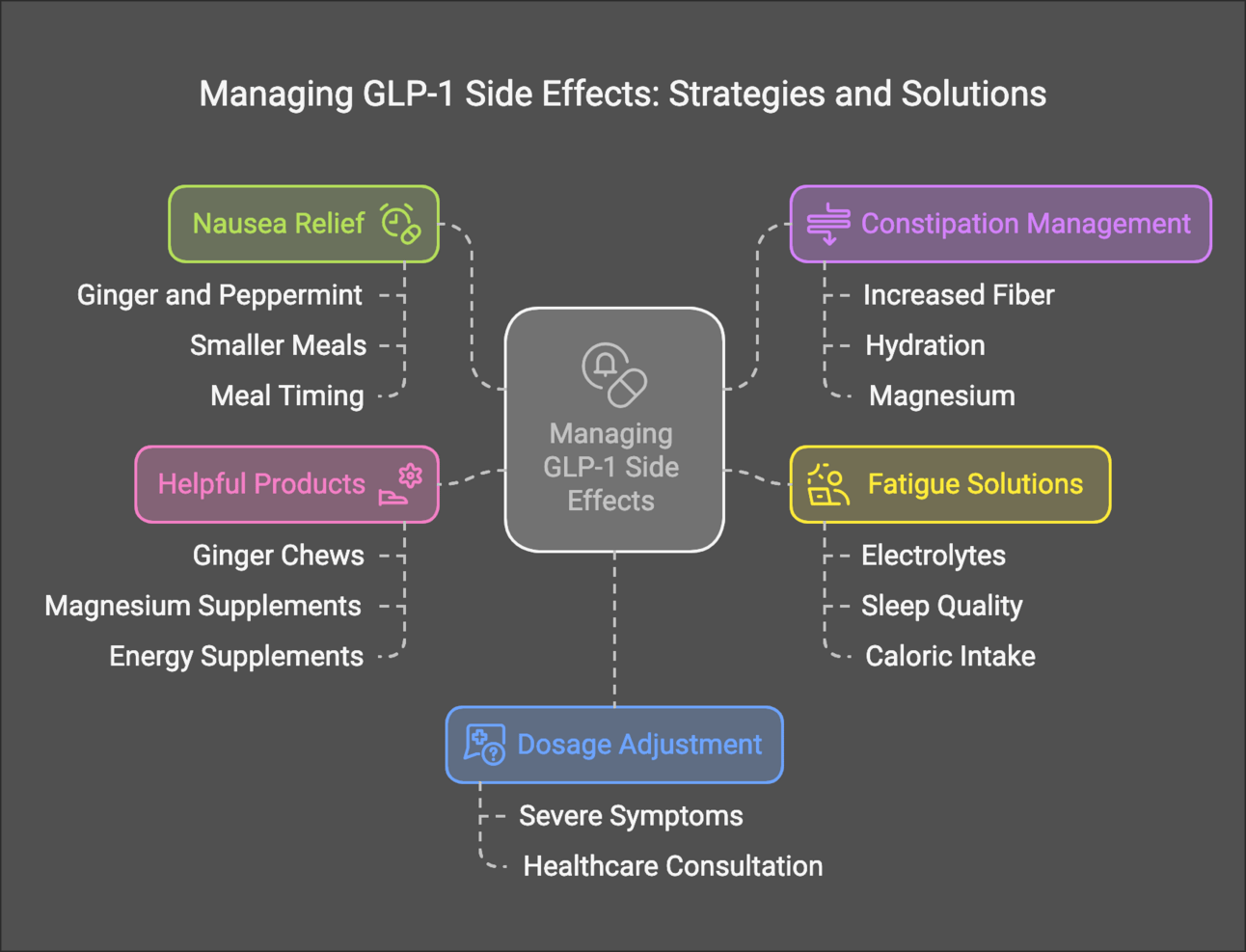- The Weekly Dose
- Posts
- Managing Side Effects: The Best Strategies for a Smooth GLP-1 Journey
Managing Side Effects: The Best Strategies for a Smooth GLP-1 Journey

Why Some Side Effects Are Common but Preventable
GLP-1 receptor agonists like Ozempic, Mounjaro, and Wegovy are revolutionizing weight loss and diabetes management, but they’re not without their quirks. Many people experience side effects such as nausea, constipation, and fatigue—but here’s the good news: most of these discomforts are manageable with the right strategies. The key is understanding why they happen and what you can do to mitigate them. A few small tweaks to your routine can make all the difference in keeping your GLP-1 journey smooth and sustainable.

Nausea Relief Hacks That Work
Nausea is one of the most common complaints among GLP-1 users, but you don’t have to suffer through it. A few tried-and-true remedies can help settle your stomach and make eating more comfortable.
Ginger, Peppermint, and Smaller Meals
Nature’s pharmacy has a few solutions up its sleeve. Ginger has been used for centuries to combat nausea and can be consumed as tea, chews, or capsules. Peppermint, whether in tea or oil form, can also provide quick relief. Additionally, consider reducing your portion sizes—large meals can overwhelm your digestive system, making nausea worse. Try eating smaller, more frequent meals to keep things balanced.
Adjusting Meal Timing: Fasting vs. Small Meals
Some people find that intermittent fasting worsens nausea, while others feel better delaying their first meal. Experiment with different eating windows to see what works best for your body. If fasting makes you queasy, opt for a small, protein-rich breakfast to stabilize your system. On the flip side, if eating too frequently exacerbates nausea, try spacing out meals and focusing on easy-to-digest foods.
How to Fix GLP-1 Constipation
Constipation is another frequent side effect of GLP-1 medications, largely due to their impact on digestion and slowed gastric emptying. Fortunately, a few simple dietary tweaks can keep things moving smoothly.
The Role of Fiber, Hydration, and Magnesium
Increasing fiber intake can help, but it’s important to do so gradually—too much too quickly can actually make constipation worse. Aim for a mix of soluble (oats, chia seeds) and insoluble (leafy greens, whole grains) fiber. Hydration is equally crucial; GLP-1 meds slow digestion, so staying well-hydrated ensures fiber does its job properly. If you’re still struggling, magnesium citrate can be a game-changer. This mineral helps relax the bowels and encourages regularity without being too harsh.
Best Foods and Supplements for Gut Health
Fermented foods like yogurt, kimchi, and sauerkraut introduce beneficial bacteria to your gut, supporting digestion. Prebiotic-rich foods like garlic, onions, and bananas nourish those good bacteria, creating a gut environment that promotes regularity. If diet alone isn’t cutting it, consider adding a high-quality probiotic supplement.
Fatigue Fixes: Is It Electrolytes, Sleep, or Undereating?
Feeling constantly drained? Fatigue can stem from multiple sources while on GLP-1 medications, but it often boils down to three main culprits: electrolyte imbalances, poor sleep, or simply not eating enough.
Electrolytes: GLP-1s can cause mild dehydration and electrolyte depletion, especially sodium, potassium, and magnesium. If you’re experiencing dizziness or persistent fatigue, an electrolyte supplement or adding more salt to your meals might help.
Sleep Quality: Many people report sleep disturbances while adjusting to GLP-1s. Prioritize good sleep hygiene—keep a consistent bedtime, avoid screens before bed, and consider magnesium glycinate to promote relaxation.
Caloric Intake: Some users unknowingly eat too little due to reduced appetite. If you’re feeling weak or sluggish, track your food intake for a few days to ensure you’re getting enough protein and healthy fats to fuel your body.
Signs You Might Need to Adjust Your Dosage
While side effects are common at the beginning, they shouldn’t be unbearable. If nausea, vomiting, or constipation become severe or persistent despite implementing these strategies, it may be a sign that your dosage needs tweaking. Talk to your healthcare provider if you:
Struggle to keep food down for multiple days
Experience extreme dizziness or weakness
Have unrelenting constipation that doesn’t improve with fiber, hydration, and magnesium
A lower dose or a slower titration schedule may help your body adjust more comfortably.
Products That Can Help
Managing GLP-1 side effects doesn’t have to be a solo mission. A few well-chosen products can make a big difference in your comfort and overall success:
Ginger chews – A natural, portable solution for nausea relief.
Magnesium supplements – Essential for digestion, muscle relaxation, and overall well-being.
Best energy supplement – reduces afternoon crashes and boosts digestion and the immune system.
Maximize Your GLP-1 Results
Want more guidance? 📩 Subscribe to our newsletter to get our 5 Essential Tips for GLP-1 Success, covering everything from nutrition to exercise to long-term sustainability. Let’s make your weight loss journey stronger and healthier!